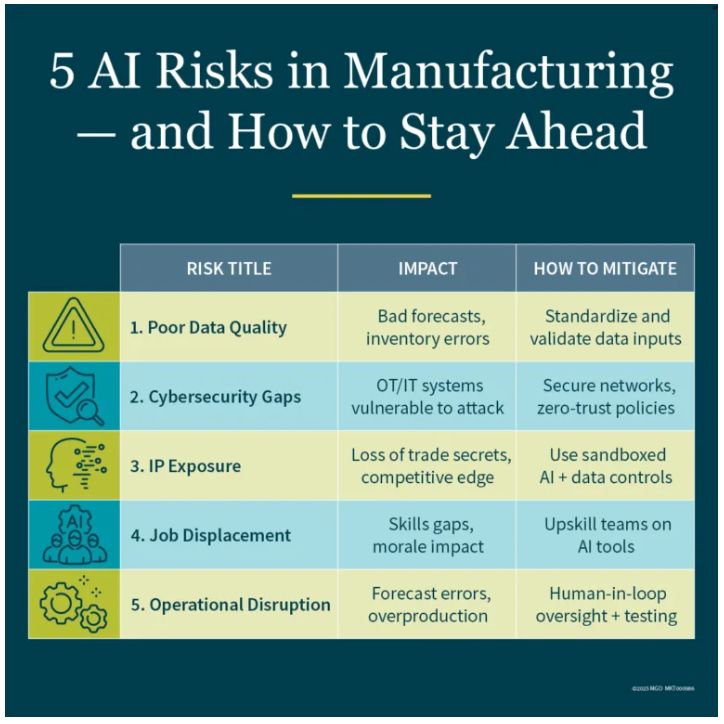- within Technology topic(s)
- in Australia
- with readers working within the Healthcare and Technology industries
- within Technology, Criminal Law and Strategy topic(s)
Key Takeaways:
- AI in manufacturing boosts efficiency, but poor data quality can lead to costly errors and flawed forecasts.
- Cyber threats grow as AI connects IT and operational technology (OT) systems. Secure your infrastructure to reduce exposure.
- AI tools risk IP leaks and job disruption. Protect proprietary data and invest in workforce upskills.
—
Amid growing cost pressures and dampened sentiment, manufacturers are turning to artificial intelligence (AI) to improve visibility, decision-making, and efficiency across complex operations. According to the Q2 2025 Outlook Survey from the National Association of Manufacturers, 84.7% of manufacturers plan to prioritize digital transformation in the next 12 months — with 21.8% placing significant emphasis on these initiatives.
While 72% of manufacturers already report measurable cost savings and performance gains from AI, overall optimism has dropped to 55.4% (the lowest level since Q2 2020). With rising input costs — particularly tariffs and raw material inflation — manufacturers must adopt AI with discipline and oversight.
But with accelerated adoption comes elevated risk. Manufacturing leaders must proactively manage the challenges AI introduces to avoid exposing the business to unnecessary vulnerabilities. This includes building strong governance frameworks with human-in-the-loop oversight, so critical decisions and outputs are always validated by skilled professionals rather than left entirely to automated systems.
Top 5 AI Risks in Manufacturing (and How to Manage Them)
Here are five critical AI risks manufacturing organizations face — and strategies to manage them responsibly:
1. Poor Data Quality Can Lead to Faulty AI Outputs
Manufacturers generate massive amounts of data from internet of things (IoT) sensors, machinery, and supply chain systems. However, if this data is unstructured or inconsistent, AI algorithms may produce inaccurate or misleading insights. This can result in flawed inventory levels, distorted demand forecasts, and even safety risks due to unreliable quality control systems.
How to manage it: Invest in foundational data hygiene and governance, such as continuous metric monitoring. Standardizing, structuring, and validating data across systems before deploying AI models is critical to ensuring reliable outcomes.
2. Cybersecurity Threats Expand with AI-Driven Connectivity
As AI tools integrate with OT and IoT infrastructure, they increase the attack surface across the manufacturing environment as well as regulatory risk exposure. Legacy OT systems, often not built with security in mind, become vulnerable when connected to AI-driven IT networks.
How to manage it: Implement robust cybersecurity protocols across IT and OT systems and adopt zero-trust architecture. Prioritize threat detection, continuous monitoring, and security-by-design when deploying AI platforms.
3. Risk of Intellectual Property (IP) Exposure
AI tools often rely on proprietary data — including process flows, equipment settings, and production methodologies — to generate insights. When shared on open platforms or in unsecure environments, this sensitive information can be at risk of theft or misuse.
How to manage it: Leverage secure AI environments with limited internet exposure and implement enterprise-wide access controls and data classification protocols. Train staff on responsible data handling practices and limit AI exposure to critical IP when possible.
4. Workforce Disruption from Automation and Digital Tools
AI technologies like computer vision and digital twins are redefining job functions on the factory floor. While these tools enhance efficiency, they may also displace certain roles — such as manual inspectors — unless companies invest in reskilling initiatives.
How to manage it: Develop talent strategies that focus on digital upskilling. Align workforce planning with technology adoption and support employees through change management and training programs.
5. Operational Disruptions from AI Model Failures
Without structured oversight, AI systems can produce unexpected outputs, including "hallucinations" — inaccurate or fabricated information. In critical functions like demand forecasting, these errors can lead to overproduction, tied-up capital, or delays.
How to manage it: Establish a cross-functional AI governance model with clear testing, validation, and human-in-the-loop oversight protocols. Embed monitoring systems to continuously evaluate model performance and flag anomalies early.

How MGO Can Help: Strategic AI Risk Management for Manufacturers
We work closely with manufacturing leaders to develop customized AI governance strategies that align with operational goals and industry regulations. Whether you're adopting AI for the first time or scaling your digital infrastructure, our solutions — including cybersecurity, risk management, technical accounting, and digital transformation — are designed to help you harness innovation responsibly.
From safeguarding intellectual property to implementing secure, auditable AI platforms, we help you drive performance while reducing exposure to operational, financial, and reputational risk. Let's build a smarter, safer future for your manufacturing operations together.
The content of this article is intended to provide a general guide to the subject matter. Specialist advice should be sought about your specific circumstances.



